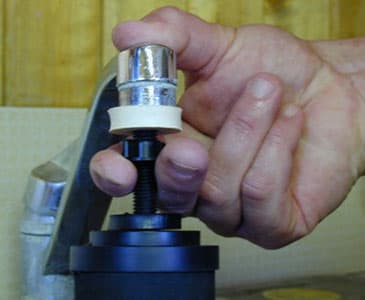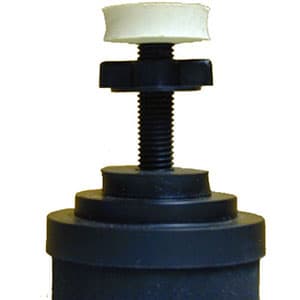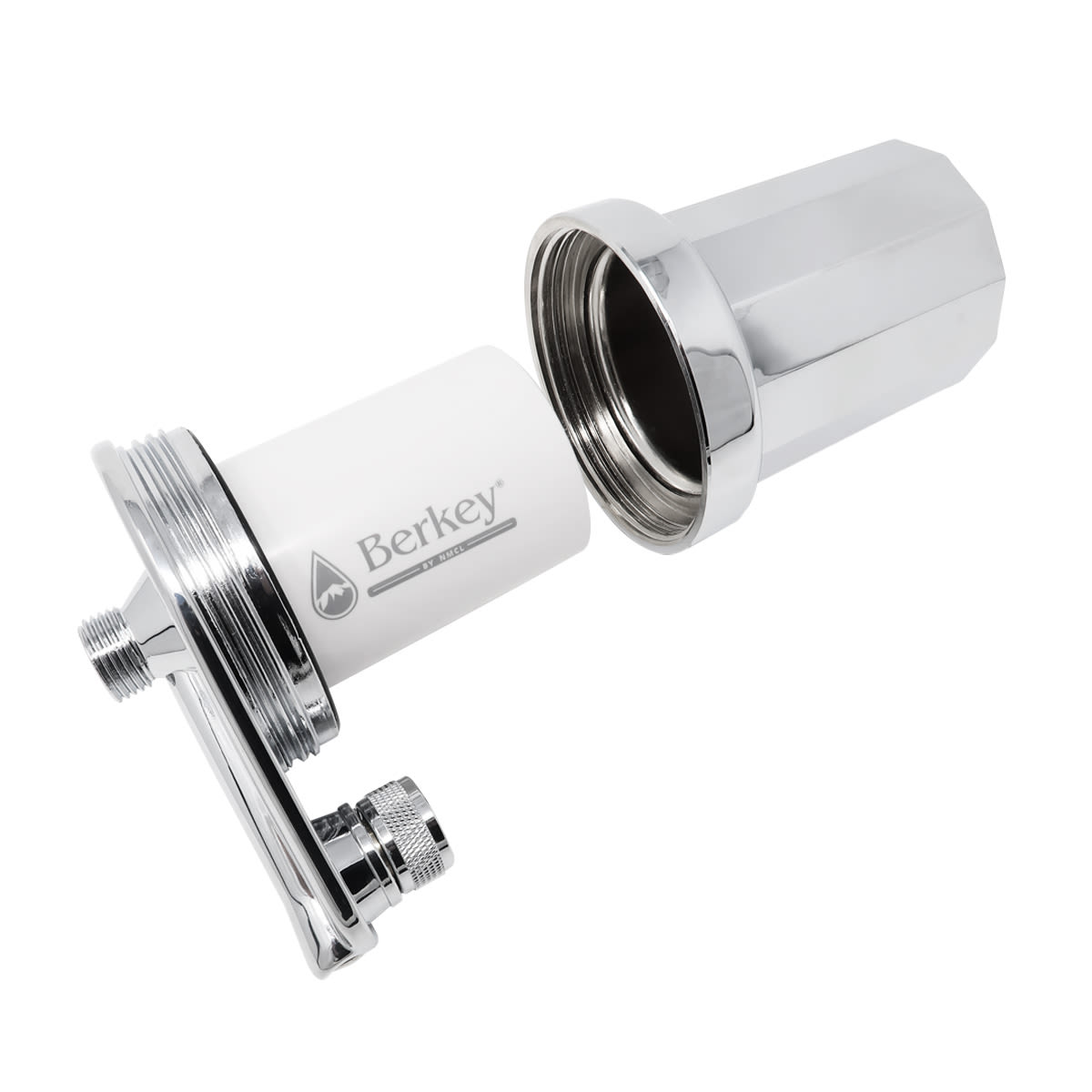Priming Black Berkey Filters FAQ'S
How do I prime the Black Berkey filters correctly?
Turn the tap on slightly so that there is a small stream of water. If the stream is too hard you'll have water squirting all over the place and if it's too slight then there won't be enough water pressure. You must create a seal between the tan washer and your tap so that the water from your tap is forced to go through the filters, thus pushing out the air in the filters. See the second photo below: Priming a Black Berkey filter element, here you see how to create the seal. Then you should see your filters "sweating" water from bottom to top, it takes about 30 seconds to a minute.
Video Instructions for Priming the Black Berkey filters.
I just bought a Berkey water purification system but it's hardly filtering any water at all. Am I doing something wrong?
The problem you are experiencing is probably due to high water tension, which is preventing the air from being purged from the micro pores of the new purification elements. Water tension varies from country to country and from area to area and can also change from season to season. The higher the water tension the more difficult it is for the water, using gravity pressure, to force the air from the micro-pores of the new element. Included with your Black Berkey filters is a tan priming washer and instructions for it's use. Please remove and prime your purification elements, reinstall them and that should correct the problem.
Priming a Black Berkey Filter Element

Priming Washer

Diagram of Priming the Berkey Purification Elements

How do I prime the Black Berkey Purification Elements, in the field, when water pressure is unavailable?
There are two methods to prime filters where no water pressure is available. You can either follow the instructions below or purchase a Berkey primer which makes priming in the field much easier.
The micro pores on the Black Berkey purification elements are extremely small, in fact they are small enough to filter red food coloring out of water. The benefit from having such extremely small pores is greater efficiency at removing pathogenic bacteria and other contaminates. The downside is that too much water tension can require that the purification elements be primed before they will flow properly. When you receive the purification elements, they are dry and air is trapped within the tiny micro fine pores. In certain parts of the world, water has more water tension than in other places and this can change from season to season. The higher the water tension, the more difficult it is for the water to force the air out of the micro fine pores using gravity alone. The pores that have air trapped within them do not allow water to pass through and therefore become an inaccessible passage for the water. This then can cause the system to either filter very slowly or not at all.
Before traveling to the field or using the system in an area without water pressure, we recommend that the purification elements be primed using the priming button method. If water pressure is not available to use the priming button method, the elements can be field primed approximately 50-75% by using the below method. In other words by using this method, the elements will not purify as fast as they will by using the priming button method however they will run significantly faster than if the elements have not been primed at all. The field priming method is as follows:
Step 1: Fill the lower chamber with water, then place the purification elements into the water in the lower chamber, upside down with the stems facing upward. Put a ceramic coffee cup (or something else that will hold them under the water) on top of each purification element stem to force the element down under the water.
Or, install the elements upside down in the upper chamber so that the elements are on the exterior of the bottom side of the upper chamber facing downward. Then place the upper chamber onto the lower chamber so that the filters are forced into the water within the lower chamber.
Let the purification elements soak in the water for 30 to 60 minutes until they fill up with water. NOTE: Make sure that the opening in the stems of the purification elements are not underwater as the water must be forced through the pores of the element and not allowed to enter the element through the hole in the stem.
Step 2: When the inside of the purification elements are full of water they will be significantly heavier. Next, assemble the purification elements into the upper chamber while keeping the stems of the elements facing upward. It is important to keep as much water on the inside of the purification elements as is possible. Next, fill the upper chamber with water as quickly as possible. Hint: the fastest way to fill the upper chamber is to pour the water from the lower chamber into the upper chamber. Then place the upper chamber onto the lower chamber.
When the purification elements have water within the bore (inside core), more force is generated to draw water through the purification elements. This is because the water that drips out of the purification element also hydraulically pulls new water into the element as it begins to work like a siphon. Thus, in addition to the "Push" of gravity, there is also a hydraulic "pull" and this drastically improves the ability of the water to force the air from the micro pores. The above method is less efficient than priming the purification elements with the priming button but should be about 50-75% effective in clearing the blocked micro pores.
Let the water from the first purification cycle that is collected in the lower chamber run to waste. Next, refill the upper chamber with water. Your Black Berkey elements are now FIELD primed and your Berkey system is ready for use.
Note: If the water used to field prime the elements is from a contaminated or suspect source, if possible use a container other than the lower chamber to immerse the elements. If this is not possible then use the water that collects in the lower chamber from the first purification cycle to make a soapy dishwater. Then wash thoroughly the inside of the lower chamber and discard the soapy water. Next, purify more water and use it to rinse any remaining soap from the lower chamber. Your Berkey system is now ready for use.







